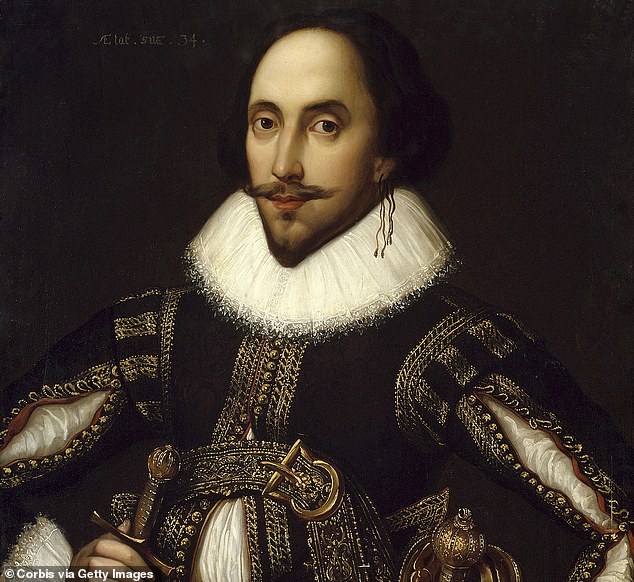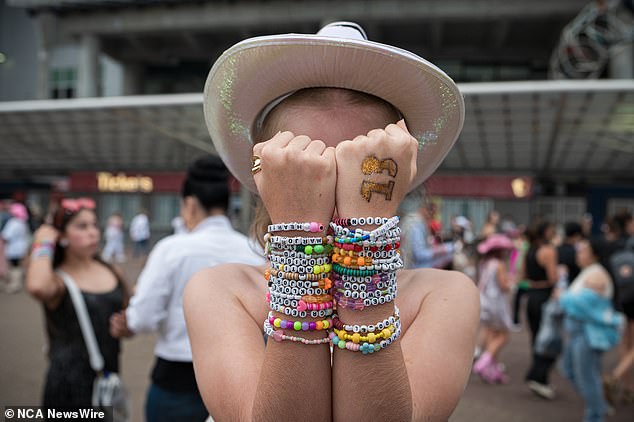As the V&A advertises for a ‘Taylor Swift Super Fan Adviser’, an Oxford graduate who wrote a dissertation on the singer provocatively claims she is as culturally important as Shakespeare, Chaucer and Wordsworth
How far has the world traveled in the 125 years since Queen Victoria laid the foundation stone for London’s V&A Museum to today, when that venerable establishment advertises a ‘Taylor Swift Super Fan Adviser’.
The position – for a dedicated Swiftie (as fans of the 34-year-old singer are known) – requires someone to provide expert insights into fan culture and the memorabilia fellow Swifties collect and create, such as concert signs and friendship bracelets. The museum hopes to have his new appointment before the fourteen-time Grammy winner starts the European leg of her Eras tour in May.
Inevitably, the news horrified cultural purists. They cry that this deification of a pop starlet known for her string of high-profile boyfriends and fashion sense will tarnish the hallowed halls of one of Britain’s most exalted institutions. She is not cultural enough, not literary enough, not earning enough. How will tributes to her sparkling outfits fit with Rodin’s sculptures and all those paintings of the Virgin and Child?
Frankly, they couldn’t be more wrong. Taylor Swift is as important to world culture as any of these great pieces.
I write as someone who completed my English degree at Oxford University two years ago with a thesis entitled ‘Is it romantic how all my elegies praise me’ – Taylor Swift as a modern romantic poet’.
It placed Taylor Swift alongside Romantic poets William Wordsworth and Lord Byron. I based my thesis on ‘the lakes’ (no, this is not an error – Swift is erratic with her capitalization), a song from her album ‘folklore’.
Lines like ‘Take me to the lakes where all the poets died’ obviously refer to the Lake District, home of Romanticism. With ‘Tell me what my words are worth’ she calls Wordsworth the father of Romanticism. I created my Swift thesis as a fan, of course, but also in appreciation of a young woman whose work I think the world should appreciate for its literary weight.
Taylor Swift will perform at the Melbourne Cricket Ground in Australia this month
Wordsworth said that poetry was the “spontaneous overflow of powerful feelings.” In this way, Swift’s lyrics are undeniably poetry. They evoke floods of tears from those who have never had their hearts broken, vengeance from those who have never been betrayed, and joy from those who feel robbed by the state of their lives.
Like all great writers, she speaks of universal experiences. Her cult classic All Too Well – so popular that she released an extended ten-minute version – is testament to this.
Everyone has been in a relationship in which he or she has felt belittled, uncared for and rejected. Heartbreaking lyrics like “You’re calling me up again, just to break me like a promise, / So casually cruel in the name of being honest” have lumped many a numb throat. For lack of a better cliché, Taylor Swift makes people feel seen and heard.
This woman is an inescapable global phenomenon. Her current tour has already raised more than £790 million and added £3.6 billion to the US economy. Both Joe Biden and Donald Trump know that 18 percent of American voters are likely to be influenced to vote for whoever they support in November’s presidential election. No wonder the V&A, one of Britain’s leading cultural arbiters, wants to recognize her status. The Swiftie track is one of several pop culture consultancies the museum recently launched. People who are passionate about emojis and Crocs shoes are also in demand. Advisors for Pokémon cards and Lego are already secured.
According to the job description, V&A’s new Swiftie advisor must have a ‘hyper niche interest’, with hair as its ‘area of expertise’.
The museum’s director, former Labor MP Tristram Hunt, said: ‘These new advisory roles will help us celebrate and explore more of the vast, and often surprising, creative diversity that the V&A has to offer, and will also help us more to learn about the design stories that are relevant to our contemporary audience.’
In recent months, more and more pillars of academia have taken Swift’s work seriously. Harvard University offered a Taylor Swift And Her World course; New York University also offers Swift classes; and Queen Mary University of London has a specific ‘Taylor Swift and Literature’ module.
Shakespearean scholar Professor Sir Jonathan Bates has likened her to a ‘literary genius’, the Shakespeare of our time. Bates, a self-confessed Swiftie, wrote an impassioned article comparing the pair and saying she is a “real poet.”

William Shakespeare, painted by Louis Coblitz. Taylor Swift has been compared to the British playwright because of her cultural significance
Swift revises and rewrites stories to suit her own time and work – most notably reprising the Bard’s Romeo and Juliet in her song Love Story and giving the young couple a happy ending. Shakespeare did the same by writing his version of Chaucer’s Troilus and Criseyde. Why should Swift be slighted and less appreciated for borrowing a story that Shakespeare had already borrowed?
She draws lines everywhere. Prof Bates points out that Swift’s song ‘invisible string’ contains the line ‘Isn’t it just so pretty to think’, which comes from Ernest Hemingway’s novel The Sun Also Rises, and the song’s premise – that two people are constantly having are connected to each other. their lives – inspired by Charlotte Bronte’s Jane Eyre.
With so many references, allusions and borrowings in her work, there is a fusion of fact and fiction that only true Swifties can identify. Hence the V&A’s need for an expert.
Her lyrics aren’t the only things embedded in our cultural consciousness. Even before the #MeToo movement and before the allegations against Hollywood producer Harvey Weinstein became public, Swift inspired other women to speak out about harassment and testified in court that she had been assaulted.
She has been a pioneer in her advocacy for artists’ rights and creative control over their work – something that has influenced the entire industry. With her new album, The Tortured Poets Department, out in April, and showing no signs of slowing down, Swift will only further cement her position as a modern icon. Swift belongs in the V&A because, whether we like it or not, she defines our culture.

A concertgoer with arms full of friendship bracelets attends the second of four Taylor Swift Eras Tour dates at Sydney’s ACCOR Stadium
The banner on the museum’s website reads: ‘If you fancy it, it’s in the V&A.’ There’s no doubt that people are “interested” in Taylor Swift. Fans in their hordes make friendship bracelets to exchange at her shows because of a line in You’re On Your Own, Kid that urges them to “make the friendship bracelets.” When I was in college I made one for a guilty pleasure party, although in retrospect I don’t think it was that guilty.
The fact is, Swift inspires a devotion and following that is almost Christ-like. How appropriate that last year an image of a Taylor Swift-inspired T-shirt was projected onto the Christ the Redeemer statue in Rio de Janeiro, Brazil, with permission from the Christ the Redeemer Archdiocese, which cares for the monument.
Here, in Britain, the V&A was originally known as the Museum of Manufactures and when it opened it was fitted with gas lighting so that it could remain open for the convenience of the working man. It was always a museum of the people to represent the people.
Today, Swift represents the people, with nearly three and a half billion views on YouTube for her song Shake It Off and 281 million Instagram followers.
And as supermodel Naomi Campbell is about to hold her own V&A exhibition, the show about fashion designer Coco Chanel is coming to an end, and with Elton John, Cher and Diana Ross all appearing in one of the current exhibitions, Diva, why Shouldn’t Swift be there? None of these exhibitions merited the call for applications for a Super Fan Adviser, which clearly shows how seriously the curators take her.
I’ve already submitted my application, despite the V&A careers site crashing on Friday, presumably because so many people had tried to gain access. Only a fool would believe that Swift’s lyrics will not be discussed by future generations in the same breath as Wordsworth’s daffodils or Shakespeare’s sonnets.
